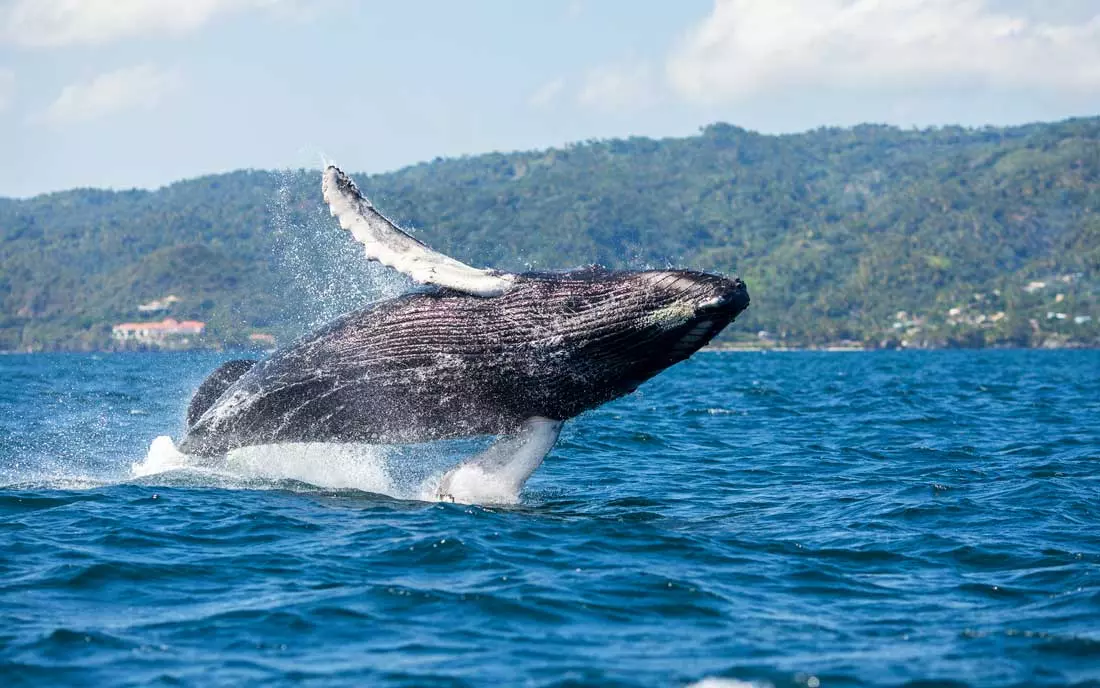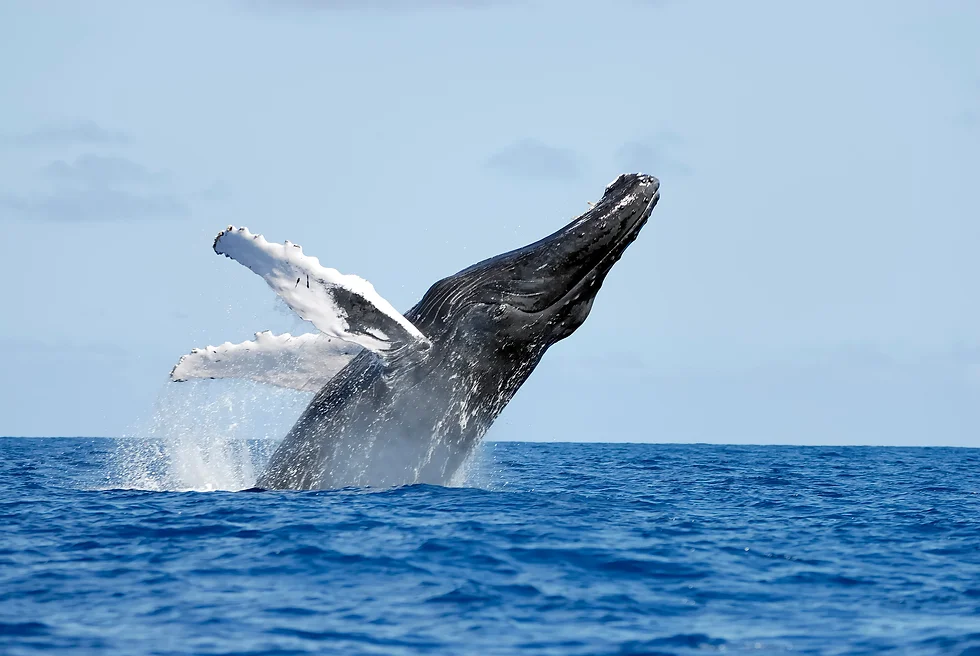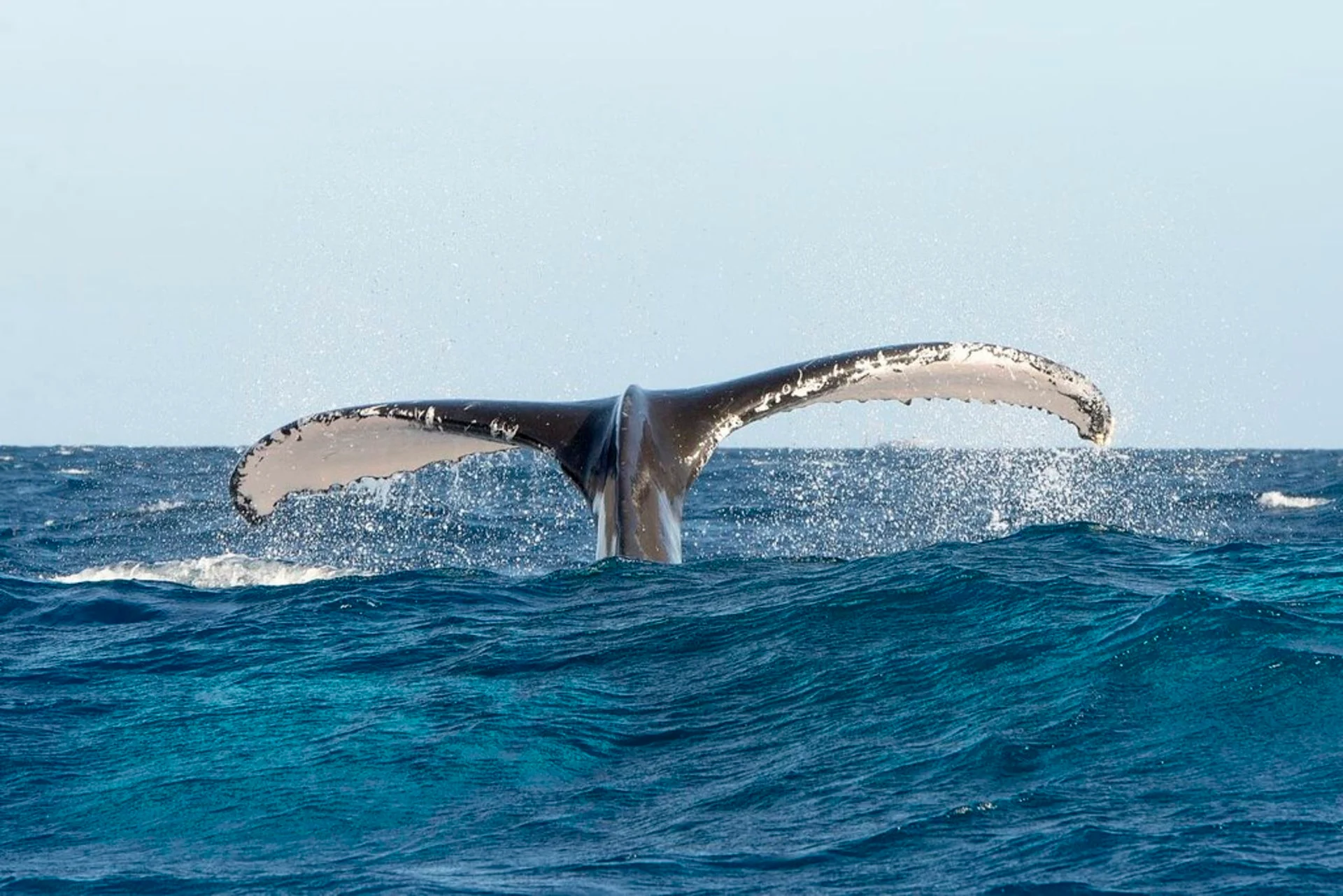The Caribbean Sea is home to some of the world’s most stunning natural wonders, and one of its most awe-inspiring spectacles is the annual migration of humpback whales in Samaná Bay in the Dominican Republic.
This incredible journey, which spans thousands of miles, brings these majestic creatures to the warm, azure waters of the Caribbean each winter – which makes whale watching in Samaná Bay a popular attraction.
In this article, we will delve into the remarkable phenomenon of humpback whale migration in Samaná Bay, exploring the reasons behind their journey, the best time to witness it, and the efforts being made to protect these magnificent marine giants.
Here is an overview:
- The Humpback Whales: Nature’s Giants
- The Migration Route
- The Timing of the Migration
- Why Samaná Bay?
- Warm Waters
- Protection
- Abundance of Food
- Conservation Efforts
- Establishing Marine Sanctuaries
- Educational Programs
- Regulations
- Whale Watching Tours
- Humpback Whale Tour in the Bay of Samana
- Good to know and what to bring
- Sunscreen
- Plarized Sunglasses
- Seasickness
- Memory cards
- Best seat for the best view
- More interesting information about humpback whales
- Why do humpback whales sing?
- Humpback’s Jump
The Humpback whales: nature’s giants
Humpback whales (Megaptera novaeangliae) are known for their immense size, with adults reaching lengths of up to 52 feet and weighing as much as 30 tons.
These gentle giants are famous for their acrobatic displays, including breaching, tail-slapping, and flipper waving, which are often seen during their time in Samaná Bay.

The migration route
Humpback whales undertake one of the longest migrations of any mammal, covering thousands of miles each year.
They spend their summers feeding in nutrient-rich polar waters, primarily in the North Atlantic. As winter approaches and the waters cool, these whales begin their journey towards the warmer, tropical waters of the Caribbean.
Samaná Bay, with its shallow and protected waters, is one of their favorite destinations.
When to go whale watching in Samaná Bay
The humpback whale migration to Samaná Bay typically occurs between January and March. During this period, the bay becomes a haven for these marine giants, providing them with a safe and comfortable environment to give birth and nurture their calves.
It’s worth noting that the timing can vary slightly from year to year, so it’s advisable to check with local experts or tour operators for the most up-to-date information if you plan to witness this incredible phenomenon.
Why Samaná Bay?
Samaná Bay offers the humpback whales a unique combination of factors that make it an ideal location for their annual migration.
Warm waters
The Caribbean’s warm waters are perfect for giving birth and nursing their calves, providing a more comfortable environment than the frigid polar regions where they spend their summers feeding.
Every few years the cows can have a baby. After almost a year of pregnancy, the “little ones” come to the sea and are already about four meters tall. They stay with their mother for at least a year.
Protection
The bay’s shape and depth provide a natural shelter, protecting the whales from predators and rough seas.
This stunning bay is one of the most beautiful in the Dominican Republic and is fed by the Yuna River, the second largest river in the country. At its southern end it hugs the town of Santa Bárbara de Samaná, from where daily boat excursions depart.
The bay is a protected marine reserve with a safe location and deep waters. There are small islands of mangrove forests, seagrass beds and coral reefs that provide nutrients for humpback whales, turtles and manatees.
Abundance of food
Samaná Bay is rich in marine life, offering an ample food supply for the humpback whales. This ensures they can replenish their energy reserves before continuing their journey.
Humpback whales use their coarse baleen, which can be up to a meter long, to sift krill from the water and, in more northerly areas, fish. During the hunt, the animals open their mouths wide, swim into a school, and then dive down after a hearty gulp of “seawater with garnish”.
However, they only fill their whale bellies during the summer months. In winter, they feed on their fat pads.

Conservation efforts of whales in Samaná Bay
Recognizing the importance of Samaná Bay for humpback whale conservation, various organizations and local authorities have implemented measures to protect these magnificent creatures.
These efforts include:
Establishing marine sanctuaries in Samaná Bay
Marine sanctuaries have been created to limit human interference and protect critical whale habitats.
The Dominican Republic has a protected area that includes Samana Bay, Navidad Bank and Silver Bank. This area protects not only marine mammals, but also their nursery grounds and deeper waters along the coast. These waters serve as important migratory routes for the whales on their way to other parts of the Caribbean.
The Bancos de la Plata and Navidad Sanctuary is one of the first of its kind in the world to protect the habitat of marine mammals. It is the largest marine reserve in the Dominican Republic and the first in the Atlantic Ocean. Each winter (December-March), numerous humpback whales migrate from the North Atlantic to the warm waters of the Caribbean to perform important tasks such as mating and reproduction. The main haunts of these whales are the coasts of La Plata and Navidad and the Bay of Samaná.
The sanctuary plays a critical role in the survival of humpback whales, as global climate change projections suggest worrying impacts on biodiversity – especially for the Dominican Republic, with an increasing frequency of extreme weather events.
Educational Programs
Public awareness and education programs help visitors and locals alike understand the importance of responsible whale watching and conservation.
The protected area also contains other natural conservation targets, such as coral reefs and mangroves, which are of great value for conservation and local economic growth. These ecosystems are fundamental to the sustainability of fish and crustacean populations, as well as the survival of marine mammals that inhabit this coastal area.
Orderly and sustainable activities take place in the sanctuary, such as the whale watching tours, which attracts thousands of tourists. As this is a highly educational experience, both locals and foreigners can be made aware of the important role whales play in the marine ecosystem and why it is necessary to protect these species.
Regulations for whale watching in Samaná Bay
Strict regulations govern whale-watching tours to minimize disturbance to the whales and their environment.
Observation trips in Samana Bay are now well organized. There are hardly any excesses like years ago, when small boats tried to get close to the giant marine mammals with reckless maneuvers.
A local organization ensures that only suitable boats and trained skippers go out and that certain rules are followed, such as minimum distances from the whales. For example, a boat can stay with a group of whales for a maximum of 30 minutes, after which it must turn away and look for other whales. Also, no more than three boats should be with a group of whales at the same time.
In addition, clear guidelines have been established for surface whale watching. These rules define the speed and direction from which whales may be approached. They also define an accepted method for encountering whales in the water – known as a soft-in-water encounter.
- Waiting boats must maintain a distance of 250 m from the whales;
- Vessels must maintain a minimum distance of 50 m from adult whales and 80 m from a group with a calf;
- Once the viewing distance is reached, the engine should be switched to neutral. It is prohibited to turn off a vessel’s engine while observing whales;
- Vessels may not travel faster than 5 knots (9 km/h) once inside the sanctuary or whenever a whale is observed outside the sanctuary;
Whale watching tours in Samaná Bay
“Suddenly, right in front of the boat, a whale weighing tons shoots out of the water almost vertically, spreads its pelvic fins, and then slams back into the water with a huge crash.”
For those fortunate enough to visit Dominican Republic during the migration season, whale watching tours are a must-do activity.
Knowledgeable guides and boat operators offer a chance to witness these incredible creatures up close while respecting their natural habitat.
The annual migration of humpback whales to Samaná Bay is a testament to the marvels of nature and a reminder of our responsibility to protect and conserve these incredible creatures. If you’re planning a trip to the Dominican Republic, consider scheduling it during the migration season for a once-in-a-lifetime opportunity to witness these gentle giants in their natural habitat.
By embracing responsible tourism and conservation efforts, we can ensure that future generations can continue to marvel at the beauty of humpback whales in Samaná Bay.
In addition to boat tours, you can admire the bay from a great viewpoint along Avenida Marina in Samaná, or walk across the bridges to nowhere that connect several mangrove coves.

Humpback whale tour in the bay of Samana
Departure is at 7:00 a.m. and at 9:30 a.m. you will arrive at the port of Miches. Breakfast will be served on the dock.
Then you will start your whale watching trip, which lasts between 2 and 3.5 hours. Sometimes the whales show acrobatic tricks right at the beginning and after 2 hours of observation you return to the port.
However, it may take a little longer to find a spot in the bay where you can watch the shy whales. In this case the operator will extend the time at sea.
After returning to port, you will enjoy a lunch break at a local restaurant with delicious Dominican food.
After lunch you will be driven 20-25 minutes to Montana Redonda. From the base of the mountain you will be taken by jeep to the top where you will have a magical view of the north coast of the Dominican Republic.
Here you can take breathtaking pictures and feel like you’re in Dominican heaven – thanks to the swings!
And you have the opportunity to go ziplining.
After these great discoveries, you will go back down by jeep to take great photos of the lush nature.
Back at base camp, your transportation back to the hotel will be waiting for you around 17:00.
Price: $154 USD (Children: $95 USD)
Availability: Every year from January 20th to March 30th, on Tuesdays and Sundays
Duration: 8-9 hours
Free cancelation
As there are only two departures per day, it is advisable to book as early as possible. This way you can be sure to get a seat and see these majestic animals with your own eyes. This is because only three boats can be on the water at any one time and the time available for whale watching in the Dominican Republic is limited.
Avoid booking this excursion until the end of your vacation in the Dominican Republic. If the weather is bad or the sea is rough, it will not be possible to observe the whales in the Dominican Republic. Therefore, it sometimes happens that boat trips are postponed to a later date (free of charge!). If you are not in Samana (or Punta Cana) at that time, you will not be able to see the whales.
The tour includes:
- Pick up from hotels in Bayahibe, Dominicus, Punta Cana, Bavaro and Uvero Alto
- Comfortable and air-conditioned transportation
- Whale watching on a motorized catamaran adapted for this purpose
- A national guide
- A lunch
- All drinks
- Entrance to Montana Redonda
- The jeep to reach the top of the mountain
Good to know and what to bring
Sunscreen
Don’t forget to apply sunscreen, the Dominican sun is constantly beaming down from the sky and the reflection of the sparkling sea water will make you burn even faster than usual.
Plarized Sunglasses
Your eyes are constantly exposed to light, especially outdoors. For example, during sports and on the water. The glare from reflective water quickly takes its toll on the eyes as the retina must constantly adapt to changing light conditions.
In these situations, polarized lenses offer a solution by blocking these blinding reflections and providing clear vision. The light is attenuated and no longer blinding. As a result, you see much clearer and sharper, including through the water surface. Your color perception is also improved.
In sports and leisure, anglers are especially enthusiastic about polarized lenses to help them see fish under the water. So having and using polarized sunglasses is definitely an advantage on your whale watch tour.
Here we have a travel tip, where we list our favorite sunglasses for the beach.
Seasickness
Be prepared for seasickness. After all, you are going out to sea, and the sea can be particularly wild. Keep your eyes on the horizon and don’t forget to breathe. Avoid alcohol the night before your whale safari in the Dominican Republic. It is important to stay hydrated (drink plenty of water).
A place where there is not so much rocking is far down, at the back and in the middle of the ship. However, you will not be able to see the whales as well from here. 😉
Doesn’t help and you want to be on the safe side? Then take a pill to prevent seasickness.
Memory cards
Bring plenty of memory cards! It is difficult to get good shots of tail fins, backs and huge jumping whale bodies!
Often you don’t know where the whales are going to surface next, and the constant rocking of the boat makes photography even more difficult!
Also, don’t forget to shoot some video, as you will no doubt want to share your Dominican Republic whale encounter with family and friends!
Best seat for the best view
For the best view, try to sit on the upper deck. From there you will have a clear view of the whales (there are no side walls or roof to obstruct your view). Also, from above you can see their silhouettes in the clear water – a really nice subject for photos.
More interesting information about humpback whales
Why do humpback whales sing?
All beaked whales make sounds, but humpback whales have the most extensive repertoire. A group of scientists at the University of Queensland in Australia has so far identified 622 different sounds – squeaks, cooing, whistles, hums….. The whales put them all together in songs, the verses of which are repeated over and over.
Each whale literally adds its own note to the piece, and although the animals of a group in a particular area always sing the same song, they compose a new “smash hit” from it every year – with a volume of up to 190 decibels, their underwater music echoes through the oceans: it is clearly louder than a jet plane taking off!
Firstly, only male humpback whales sing, and as is so often the case in the animal kingdom, they are courting the females – sometimes for up to 20 minutes at a time. Second, it is particularly noisy underwater in the winter, when these marine mammals are in warmer tropical areas looking for a mate:
In summer, the animals feed in the colder regions of the Arctic and Southern Seas, filtering krill from the water. In the winter, however, the singers can spit out loud sounds while feeding on their fat reserves.
The males usually sing together in a chorus to attract females — the more voices, the better. It is then up to the cows to choose which whale to mate with.
Humpback’s jump
Besides all the squeaking and cooing, humpback whales have another trick up their sleeve to communicate with each other: With all their might, they lift their massive bodies out of the water and jump! They then land on the surface with a loud bang, sending their message across the oceans.
The sounds travel long distances as sound waves. When the whales want to “chat” with other animals in their vicinity, they simply slap their long pectoral fins against the water. What exactly are they trying to tell each other? That is still a mystery to researchers.
During the time that humpback whales are mating, they jump out of the water many times more than under normal circumstances. The exact reason for this behavior is not fully understood, but it is believed that the males do this to attract the interest of the females.












